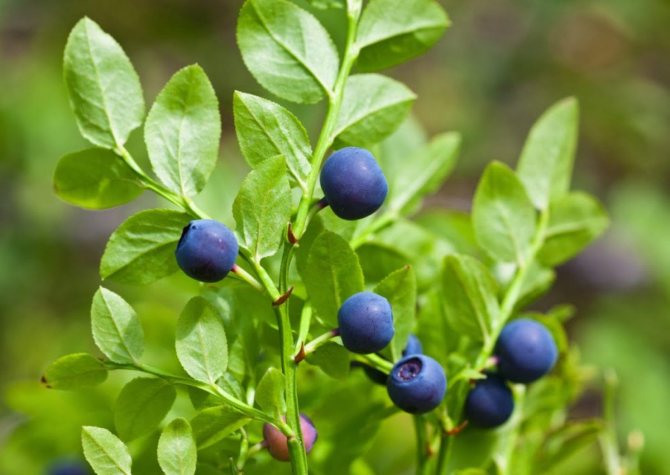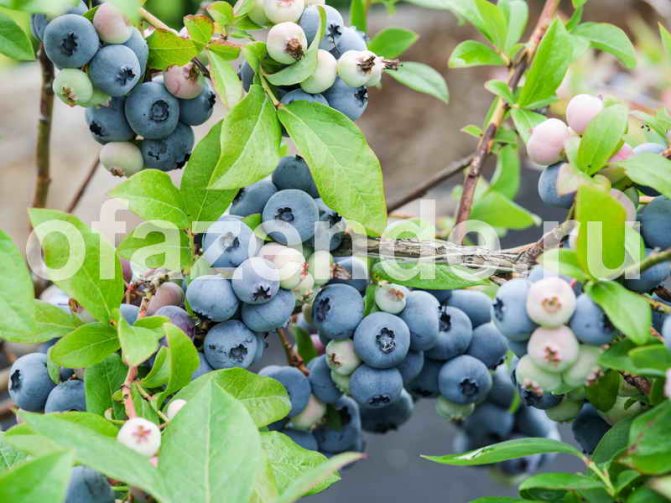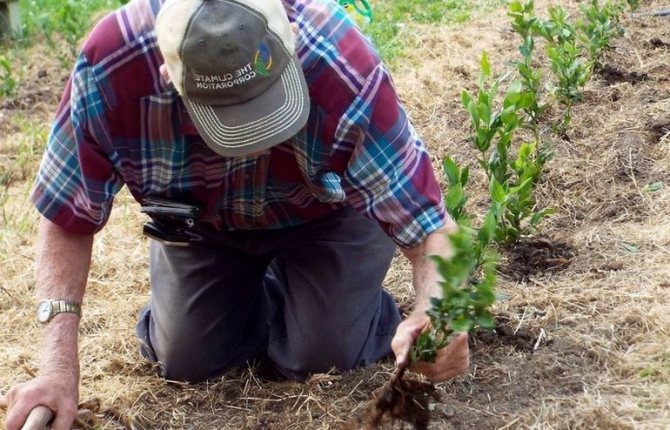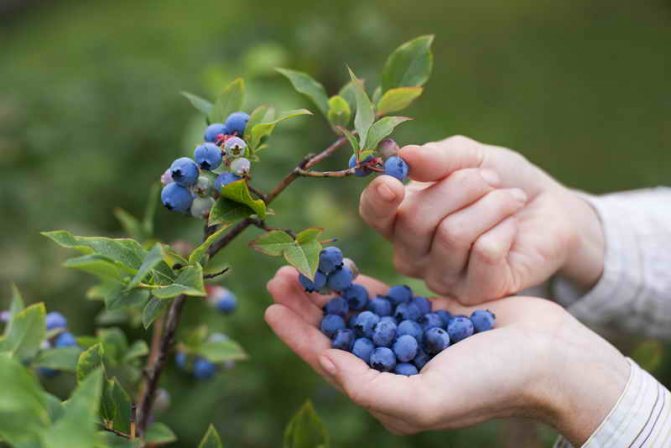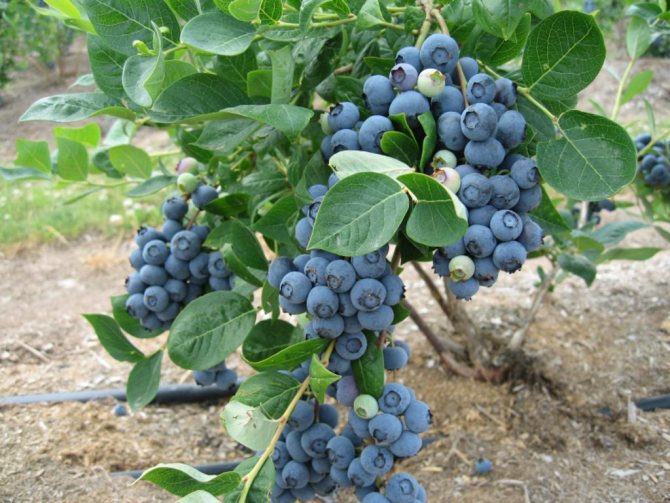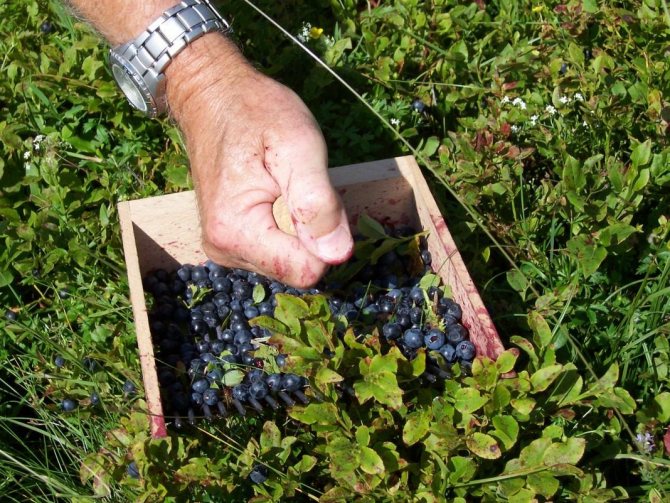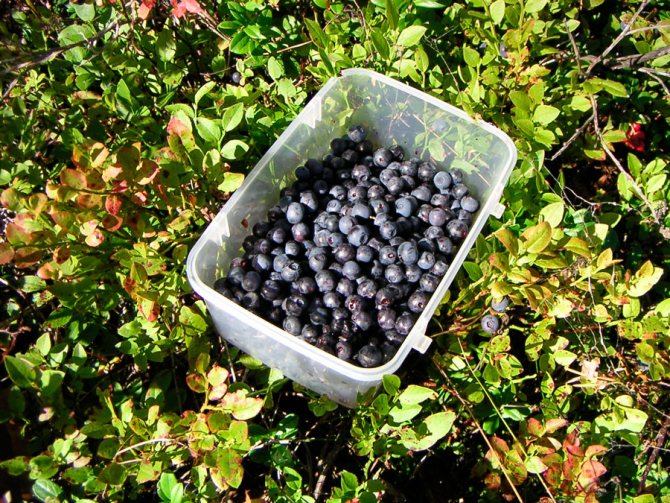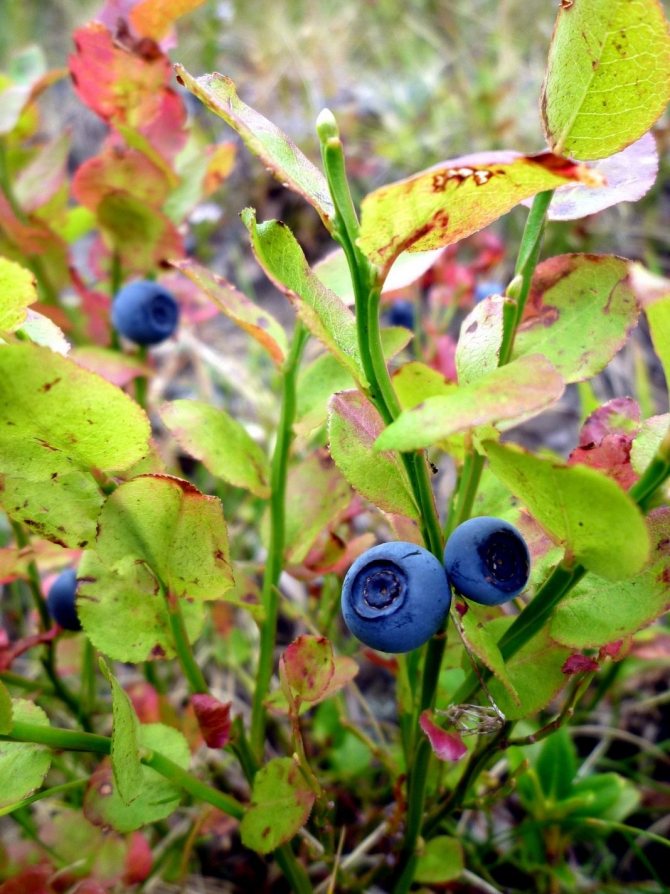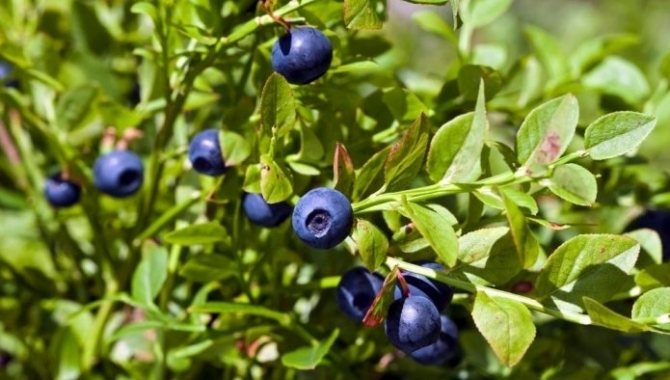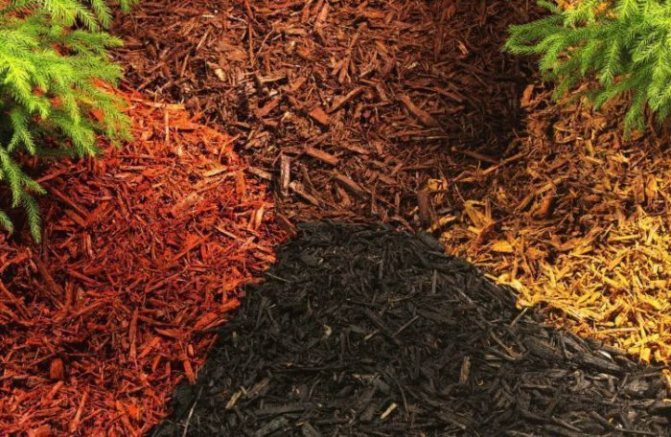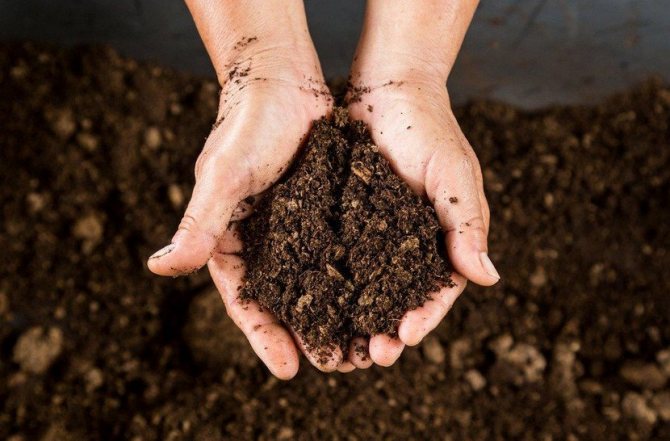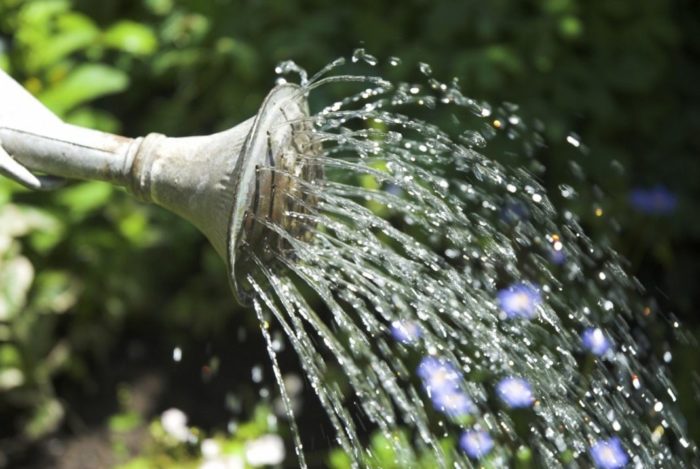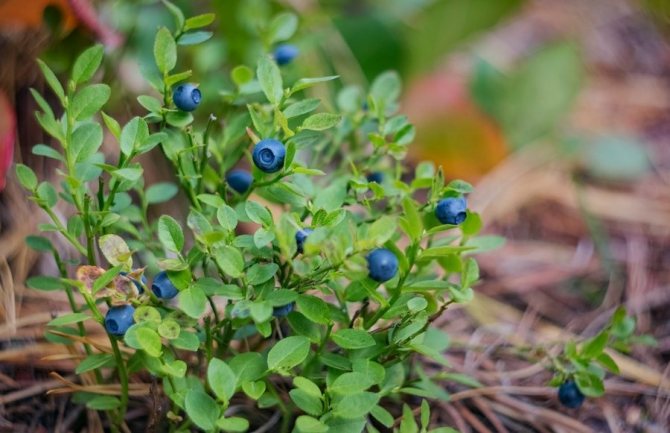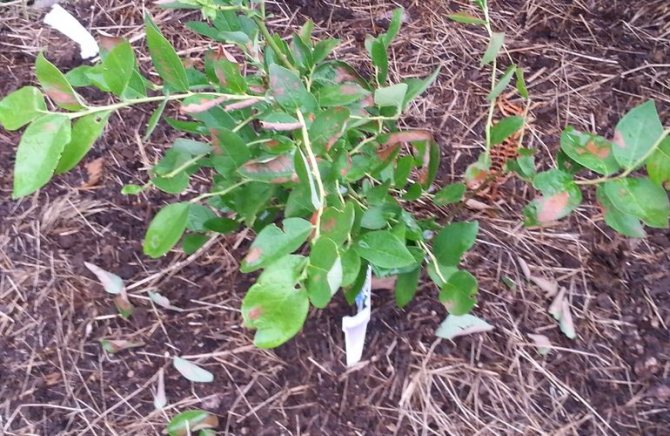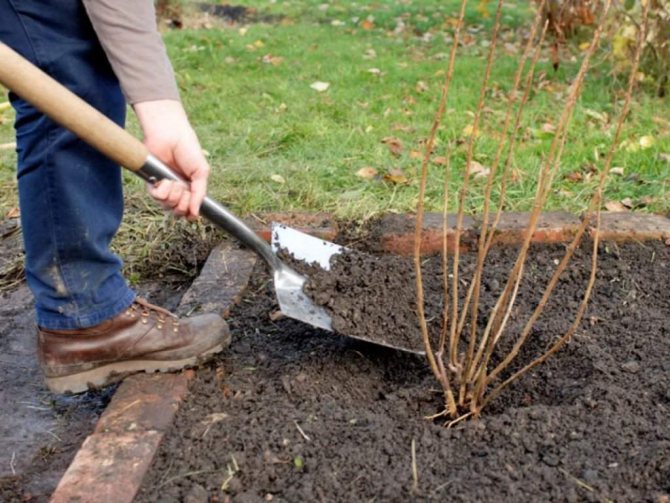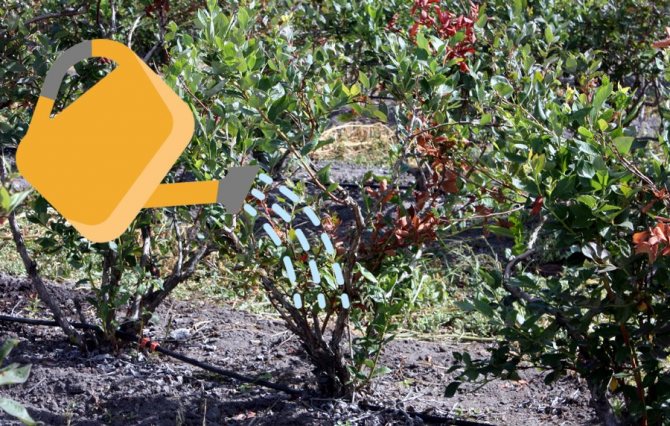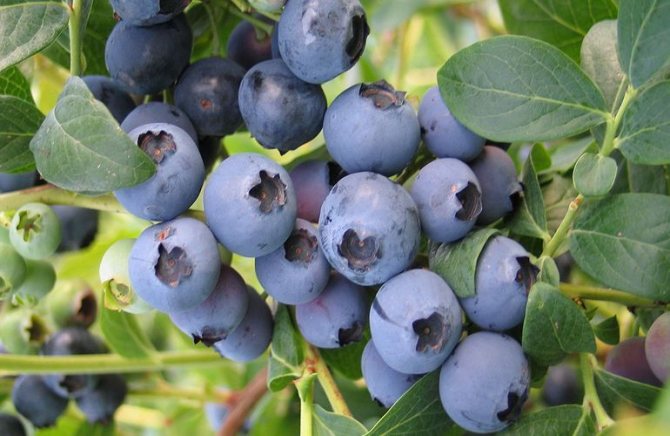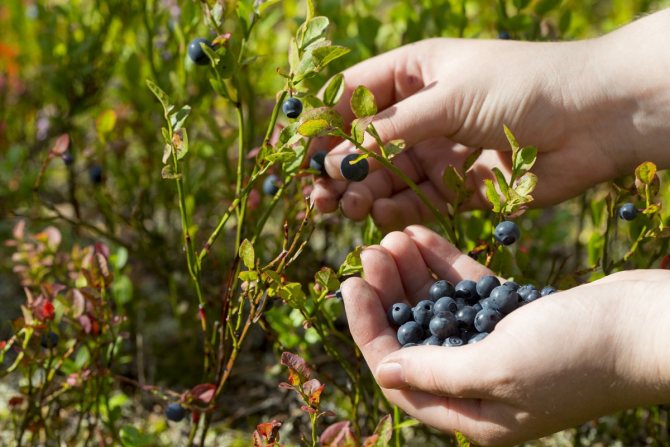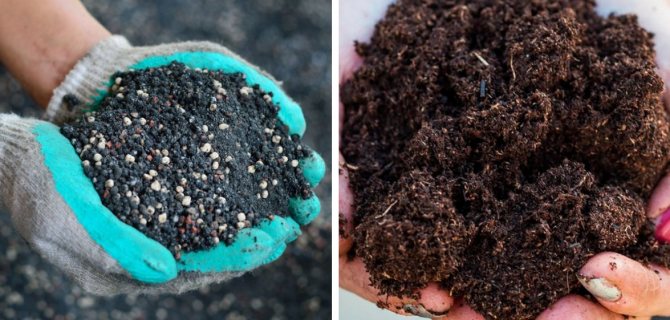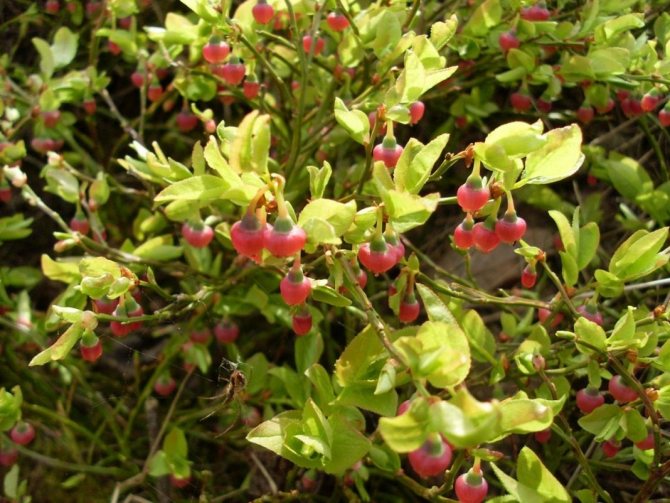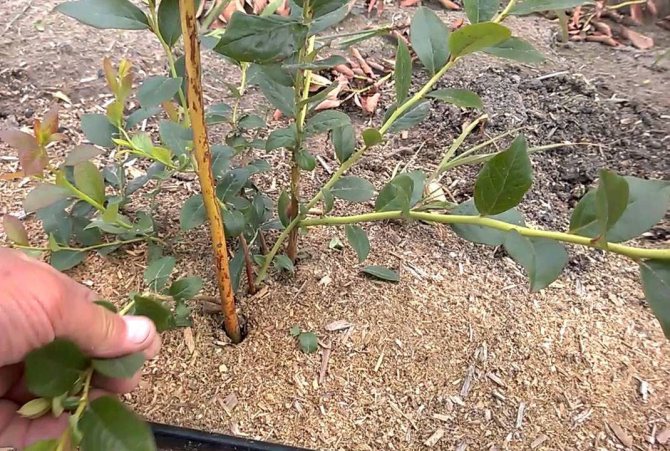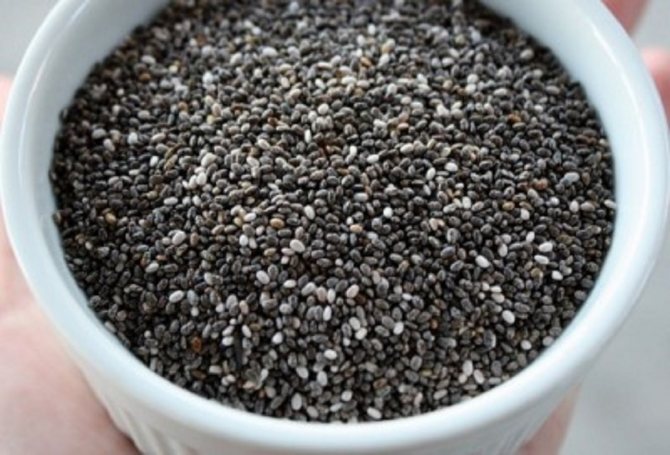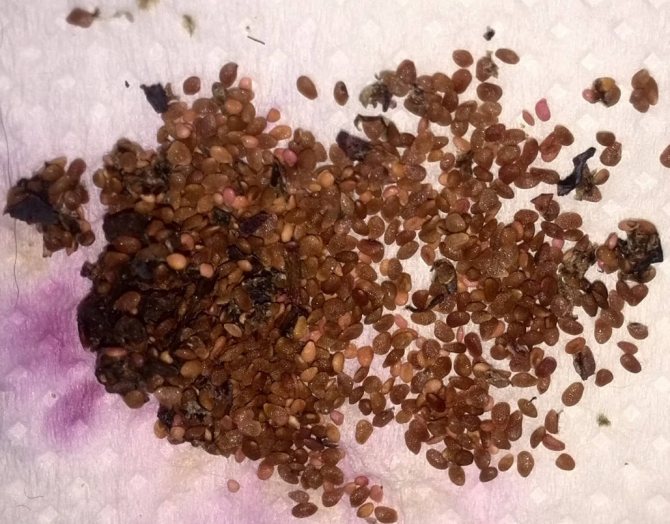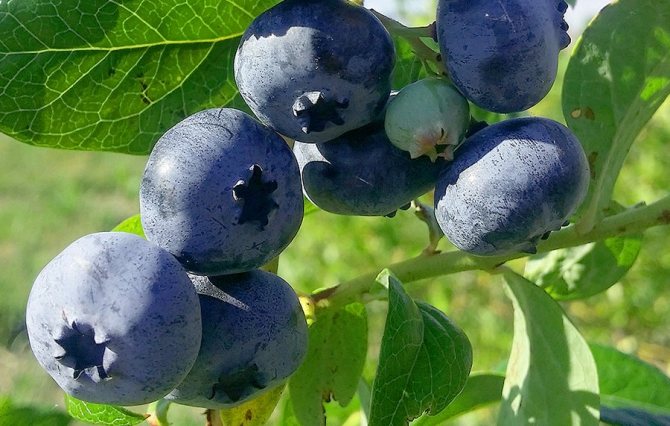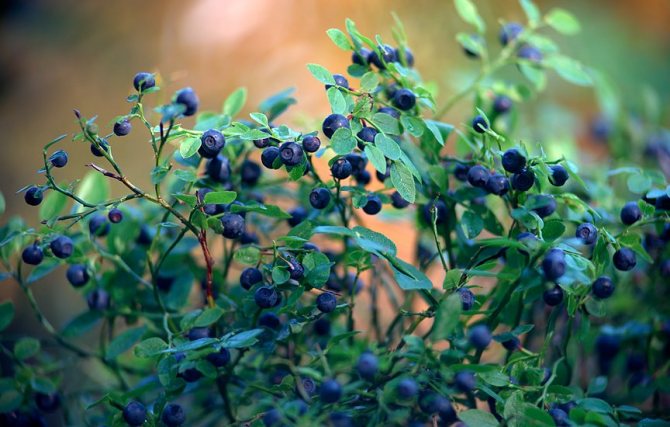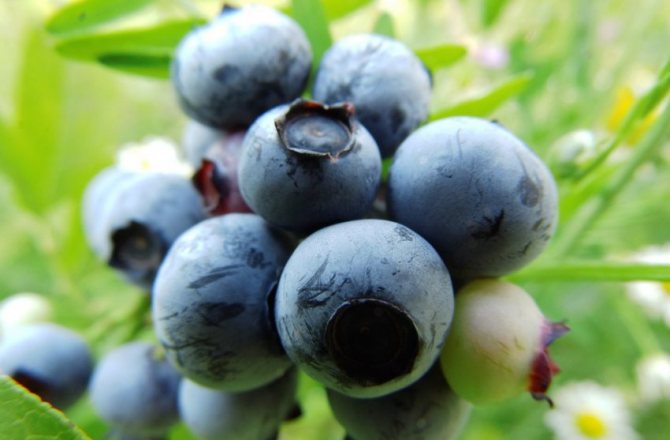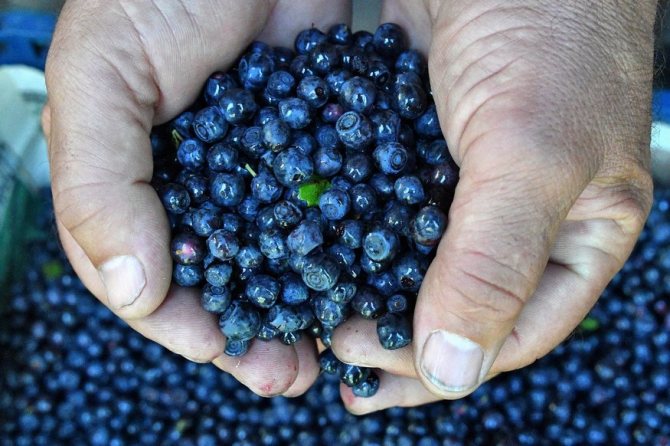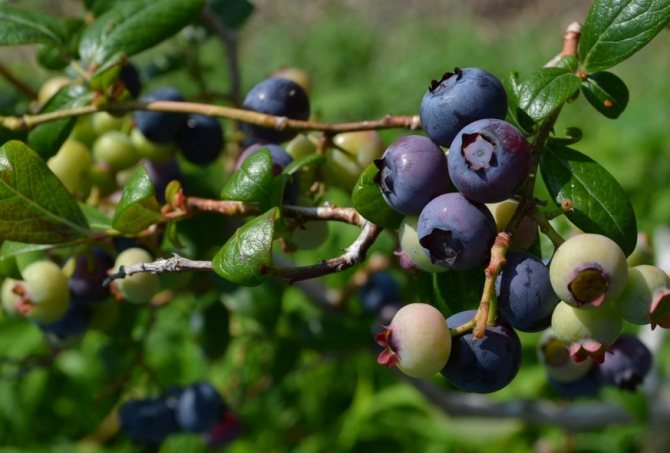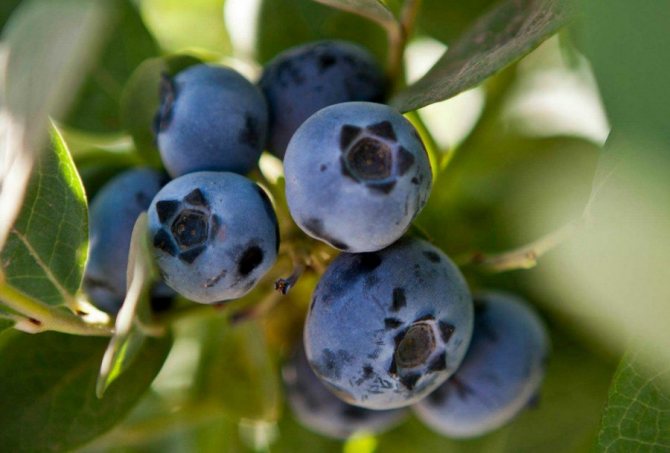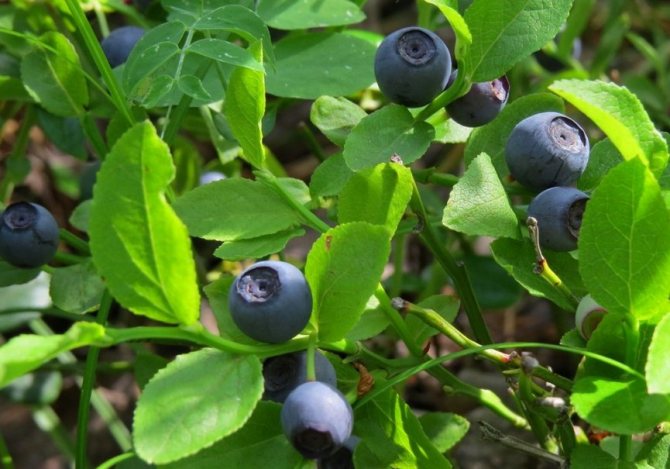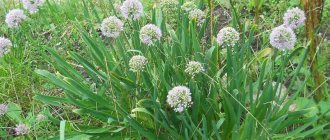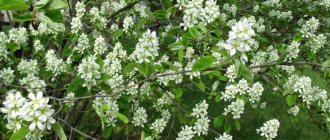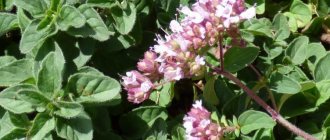Blueberry is a common berry crop that grows in Northern and Eastern Europe, taiga and tundra regions of Asia, and North America. In the wild, this is a low-growing shrub, some species of which do not exceed 10-15 cm. Many gardeners, not wanting to go to the forest for berries every summer, try to equip their own blueberry in their garden plot. In most cases, the transfer of a forest plant to artificial conditions ends in failure. Blueberries are accepted, but no fruit. When planting specimens purchased in specialized stores, consumers note that they have little in common with wild berries. Garden Blueberry or Bilberry Tree is a hybrid species intended for outdoor cultivation.
Photo of garden blueberry:
When is it better to plant blueberries: features of spring and autumn planting
The optimal time for planting garden blueberries in spring is in mid-April and in autumn in October. Both spring and autumn planting have a common disadvantage: due to sudden frosts, the plant can freeze out. It is better to plant blueberries in the fall, since the survival rate of plants at this time is much higher, and the planting material, as a rule, is of better quality.
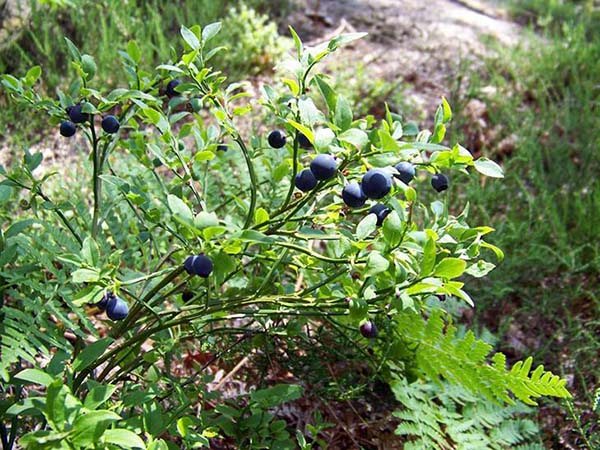
Features of growing blueberries from seeds
The enthusiastic gardeners who love to watch every stage of growth grow blueberries with seeds. This method is not very popular with novice breeders, since it takes a very long time to wait for the first harvest.
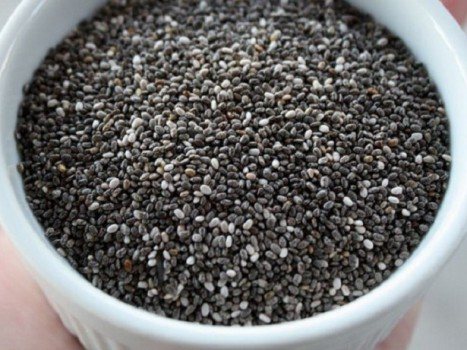

Planting blueberries with seeds is done as follows:
- Ripe or melted after freezing, the berries are thoroughly kneaded in the hand, and then the resulting gruel is poured into a container with water.
- The mixture is stirred until the rind and empty seeds emerge.
- The trash is drained and the seeds are washed with water.
- The clean planting material is shaken out of the container, slightly dried and sown in seedling boxes filled with peat.
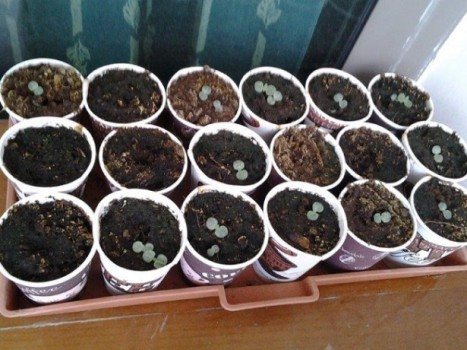

After 2-3 weeks, when the seedlings have risen, the temperature in the room is gradually lowered to + 5- + 10 C. In the spring, the strengthened plants are transplanted into larger pots. In open ground, blueberry seedlings are planted at the age of 2 years.
Video: planting and growing blueberries from seeds
How to plant blueberries: features and step-by-step instructions
Blueberry is a plant that is extremely demanding on the soil and the environment. So, in order for the shrub to take root and soon please with sweet and sour fruits, you need to follow a number of rules for planting and caring for garden blueberries.
What should be a seedling
The best planting material for blueberries is 2 or 3 year old seedlings with closed root system... Of course, bushes with open roots can also be planted, but on the counter they dry out very much, as a result of which they do not take root well. The bushes should look healthy and the roots should be visible from the drainage holes. Before planting, the young plant is carefully removed from the container, the roots are straightened, and the shoots are shortened to a height of 20-30 cm.
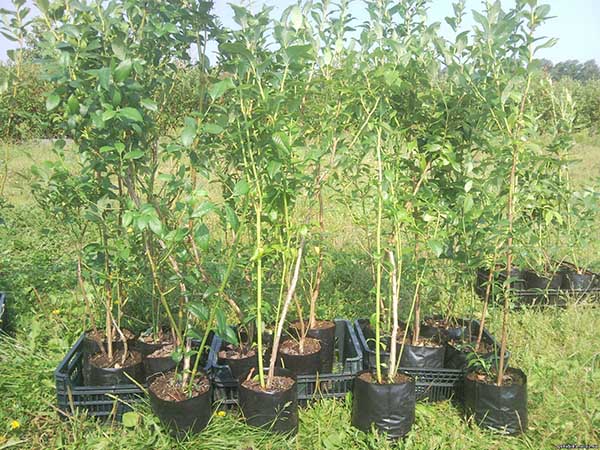

Pick-up location
Due to the fact that under natural conditions blueberries grow in forests, it is best to plant a plant in the country. in partial shade... But it is undesirable to plant a plant in the shade: due to a lack of sunlight, the berries will be sour.The shrub can also be grown in a sunny area, however, in order to collect a good harvest, it must be sprayed 3-4 times a day. The ideal place for planting garden blueberries is near deciduous and coniferous trees.
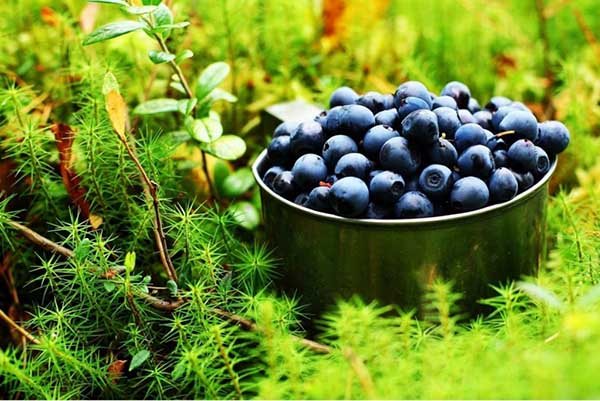

In summer cottages with loose soil, blueberries can be planted in a place where groundwater flows at a distance of 30-90 cm from the surface. It is impossible to plant a bush where water stagnates for a long time.
What to plant with
Due to the fact that blueberries do not like organic matter, it is forbidden to plant shrubs near crops that are regularly fed with such fertilizers. The fact is that manure and chicken litter strongly alkalize the soil, which is extremely undesirable for such a lover of an acidic environment like blueberries. A shrub growing in an area where the soil pH exceeds 5.5 units gets sick, stops growing and dies.
At what distance
In order for the shrub to have enough moisture and nutrients, the distance between the bushes should be 0.6-4.5 m.For blueberries narrow-leaved varieties enough 60 cm of free space, scutellous - 1.8 m. Bushes belonging to twig-like, planted at a distance of 4.5 m with a row spacing of 2.5 m.
What soil is needed
Unlike many cultivated plants, blueberries prefer to grow not on neutral, but on acidic soils. So, the best medium for the growth of a berry is a substrate, the acidity of which is 3.5-5 units. To bring the acidity to the desired level, the planting pit is filled with a mixture of fertile soil and peat chips (2: 1). In order to acidify the substrate even more, 150-200 g of sulfur are added per 1 square meter. River sand or sawdust is introduced into heavy soils.
Landing pit
To plant garden blueberries, dig a hole 60 × 60 cm deep 50-80 cm. A layer of broken brick, pebbles or rubble is laid on the bottom. Then the planting hole or trench is covered with the prepared substrate for most of it and left to stand for 2-3 weeks. So that the earth has time to settle, the preparation of the deepening begins a month before the expected date of planting.
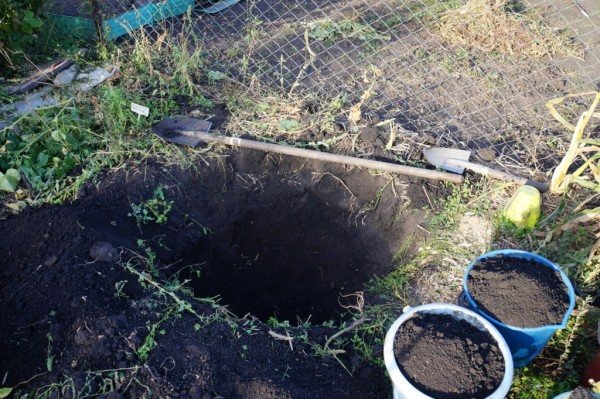

How and what to fertilize before planting
Since blueberries love an acidic environment, the soil for filling the pit is mixed with high peat, coniferous sawdust or rotted oak leaves. To acidify the soil, colloidal sulfur is poured into the pit or poured with a solution of citric acid (1 tablespoon of the substance per bucket of water).
Important! Organic fertilizers should not be applied to the blueberry planting pit, as they alkalize the soil.
Planting methods
When planning the appearance of a summer cottage, it is important to choose the right method of planting certain plantings. Blueberries, like all shrubs, are planted in the following ways:
- Into the ranks. If you want to equip a hedge or large plantations, the plants are planted in one or more rows at a distance of 2.5 m. Using this method, the bushes are placed both in separate holes and in trenches. However, the second method is quite costly, since its implementation requires a lot of peat and coniferous sawdust.
- Planting in barrels or containers. Drainage holes with a diameter of 5 cm are made in the bottom of the containers with a depth of 60 cm. A hole of the appropriate size is dug at the chosen place and the container is immersed in it. Further, the container is covered with a substrate and a bush is planted.
- To the ridges. In places where water stagnates for a long time, blueberries are planted on homemade hills. At the chosen place, a mound of substrate is poured with a height of 20-30 cm and a width of 0.9-1.2 m. The mound is fenced with boards of appropriate size made of hardwood trees - acacia, cedar and oak. Such wood is practically not subject to decay and will last a very long time.
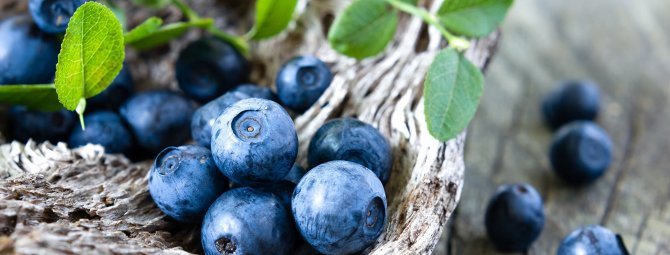

Bilberry grows naturally in northern and temperate latitudes, from the high mountains of the Caucasus to taiga and forest-tundra. The optimal conditions for it are damp pine and spruce forests.Recently, however, garden blueberries can be seen more and more often on personal plots. Delicious berries are eaten fresh with pleasure, jam is made, dried and frozen. Blueberries are also used to decorate the garden. Arranging an alpine slide, it is often planted along with other flowering shrubs: lingonberries, rhododendrons, erica.
Description of garden blueberry
Garden blueberry (Vaccinium corymbosum) is one of the variants of the name Blueberry, bred selectively in North America. Several dozen varieties are used to harvest large, beautiful berries and in landscape design.
The blueberry tree is a vigorous, spreading deciduous shrub, its height depends on the climate and conditions, ranges from 1 to 3 m, the crown diameter is on average 2 m. The root system of blueberries is fibrous, densely branched. Stems of garden blueberry are straight, strong, lengthen every year due to young growth. Shoots are medium or thin, slightly ribbed, green or greenish-red, not pubescent, shiny. The growth buds of the blueberry tree are small, oblong, pointed, located along the entire shoot and in the leaf axils. The flower buds of a blueberry tree are light green, spherical, formed on new shoots - 1 apical and 2-3 lateral ones, bloom in May. Garden blueberry leaves are medium in size, green, oval, smooth, shiny, even or finely serrated at the edges. They turn red in autumn, fall off by winter.
White or pale pink, pitcher-shaped flowers are collected in racemose drooping inflorescences. Corolla with 5-toothed joint-petals. Blueberries are round or slightly flattened, up to 2.5 cm in diameter and weighing 1.4-1.9 g, sweet, aromatic. The color varies from blue to almost black, the skin of medium thickness is covered with a bluish bloom, the flesh is light, dense. The fruiting times of the blueberry tree differ depending on the variety, the average yield is 3-5 kg per bush.
Is it possible to plant blueberries on the site
It is not necessary to go to the forest for blueberries; they can also be grown in the garden, creating comfortable conditions for them. The culture loves coolness, tolerates winter cold well, but can suffer from early autumn frosts. It takes a month and a half for blueberries to go into dormancy. If the crop is not harvested 50 days before frost, then early cold weather down to -10 ° C can damage the bush. Spring return frosts are not dangerous for blueberries, since they bloom late, in the second half of May.
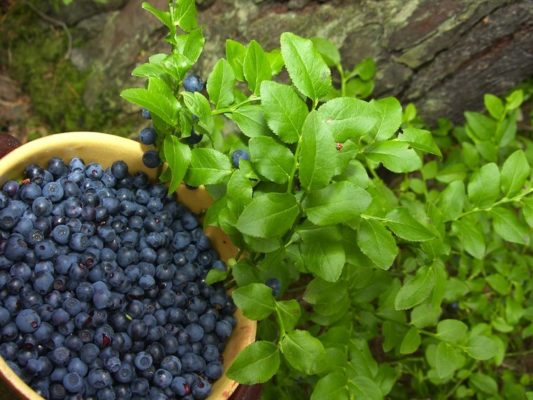

Blueberry lovers do not need to go to the forest, because you can eat them in your garden.
When growing blueberries, it should be borne in mind that they are very sensitive to lack of moisture. During the season, it is necessary to keep the soil moist, otherwise the bushes will begin to dry out.
Popular varieties
Breeders are constantly breeding new varieties of crops, and it is difficult for novice gardeners to make a choice among the wide variety. When planning the cultivation of blueberries, you should familiarize yourself with the popular varieties, which include the following:
- Top Hut. The variety represents plants up to 40 cm high. Fruits are large, with juicy pulp and pronounced aroma. Suitable for growing outdoors or at home.
- Legacy. Tall bushes reach a length of 1.5-2 m. Berries are medium-sized, with a sweet taste. The variety is prized for its stable and high yield.
- Bluecrop. The variety was obtained by crossing with blueberries. Productive shrubs yield up to 9 kg of medium-sized berries with a tart flavor.
- Spartan. The main advantage of the variety is the large size of the berries. The mass of one berry can reach 5 g. The variety is frost-resistant and is valued for its abundant fruiting.
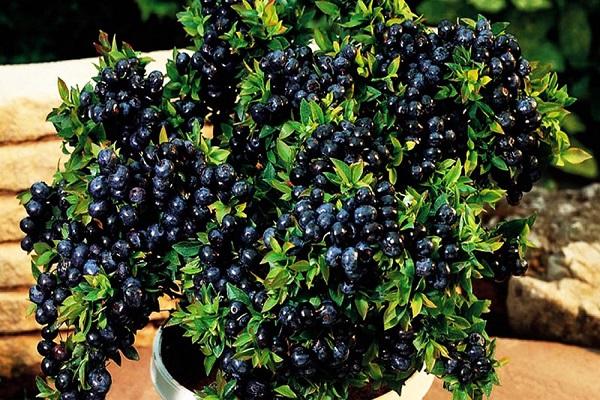

Choosing a place
The garden form of blueberries - a perennial low shrub with sweet and sour berries in appearance is no different from its forest relative. However, the growing conditions for cultivated berries are somewhat different. In the forest, the berry grows in the shade of trees; for planting in the garden, it should be allocated a sunny area. In case of insufficient lighting, the berries become smaller, the yield decreases.
Blueberries should be protected from strong winds, especially in winter. Therefore, it is better to set aside quiet corners in the southern part of the garden for planting, closed from cold winds by a fence, hedges, garden buildings. In such a place, a warmer microclimate is created, snow lingers in winter, creating a reliable protective cushion for plants.
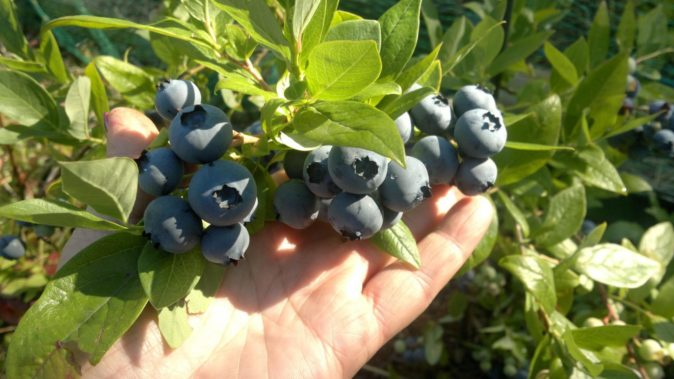

The place for blueberries in the garden should be taken as the brightest, most of the day warmed by the sun
Garden blueberries are quite demanding on the composition of the soil. It grows well on air-permeable loose peat-sandy soil with a high acidity level - pH in the range of 3.8–5. Groundwater should lie 40–60 cm from the surface of the earth, but with regular irrigation, deeper water layers are also possible. However, you should not plant bushes in lowlands or in clayey areas where water stagnates for a long time - blueberries cannot stand flooding. Clay soil can be made looser by adding a bucket of sand for every square meter.
Blueberry properties - harm and benefit
Useful properties of blueberries
The main advantage of blueberries is the antioxidants that are part of its berries. In addition to blueberries, these valuable substances are found in foods such as red cabbage, blackberries, radishes, apples, dark grapes, but all of these products are inferior to blueberries in terms of the amount of antioxidants. In addition, blueberry berries and leaves contain magnesium, phosphorus, potassium, selenium, zinc, calcium, sulfur, chlorine, sodium, iron, copper, organic acids, vitamins C, B1, B2, B4, B5, B6, PP, A, pectins, saponins, glycosides and other beneficial substances.
Blueberries have antimicrobial, anti-rotting and astringent properties. The carotenoids in their composition improve night vision, so during the Second World War, British pilots actively ate fresh berries and blueberry jam. They also feed the astronauts with blueberries.


It has long been known that eating blueberries increases the field of vision, enhances its acuity and reduces eye fatigue. But recently it has been discovered that blueberries accelerate retinal renewal and improve its blood supply. To restore vision, you need to eat on an empty stomach 30 minutes before breakfast, 1 tablespoon of fresh or dried blueberries, poured in cold water in the evening to swell.
Excellent results are obtained by using blueberries for skin rashes, eczema and scaly lichen: fresh fruit juice should be applied to the affected areas. And for burns, purulent wounds, ulcers and weeping eczema, compresses with freshly squeezed blueberry juice are shown, which are changed 3-4 times a day. When there are no fresh berries, a thick broth of dry fruits is used for compresses (100 g of berries are boiled in 0.5 liters of water until the volume is halved).
Optimal planting times
Planting time for blueberries depends on the climatic conditions of the region. It should be remembered that blueberries love coolness, therefore, in regions with a warm climate, it is better to plant them in September-October, when comfortable warm and humid weather remains. Hot days come quickly in the south in spring, blueberries may not take root and die. When planting in autumn, before the onset of frost, the plants will have time to adapt to a new place.
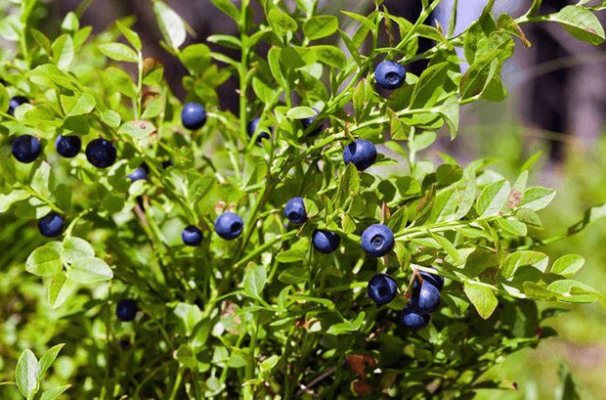

Healthy blueberry bushes quickly adapt to new conditions and soon begin to bear fruit
Planting blueberries in spring
The best time to plant blueberries in the central and northern regions is late spring, when the threat of return cold weather has passed. During the summer months, the plants will get stronger and prepare for wintering.When planting in autumn, there is a high risk of death of the shrub, since in autumn the nights here can be very cold, early frosts are not uncommon. At first, blueberries should be shaded with spunbond so that the bright spring sun does not damage the young plantings.
Landing features in different regions
Since blueberries are highly frost-resistant, the plant is grown throughout the country. However, due to the varied weather conditions, landing in the regions has some differences.


In the Volga region
In autumn, blueberries are planted in the first or second decade of October, and in spring - in the third decade of March. If severe frosts are foreseen in the region, the seedlings are covered with dense spunbond or ordinary rags.
In the middle lane (Moscow region)
Autumn planting is done in mid-October, spring planting at the end of March-April. Since the conditions of the Moscow region are very moderate, this is where the peculiarities of planting shrubs end.
In Siberia and the Urals
Since the winter of these regions is characterized by its harsh conditions, blueberries are planted in autumn in late September and early October, and in spring in April. In order to give looseness to the heavy soil characteristic of the region, sand or coniferous sawdust is added to the planting substrate.
How to plant blueberries correctly
Just like forest blueberries, garden blueberries prefer to grow in acidic soil, so prepare the site before planting. Sand, coniferous litter, sawdust are added to the peat and must be acidified. A year before planting, you can add ammonium sulfate and ammonium nitrate (20 g each), nitroammofosk and potassium sulfate (10 g per m2) to the soil. Or, in a few days, spill the soil with a solution of citric or oxalic acid (15 g per 10 l), apple cider vinegar (100 ml), powdered sulfur (60 g per m 2). If the soil on the site is heavy, a little more river sand is added to it. You should not fertilize the soil with manure or ash, otherwise the bush will only intensively increase the vegetative mass, and it will not have enough strength to harvest.
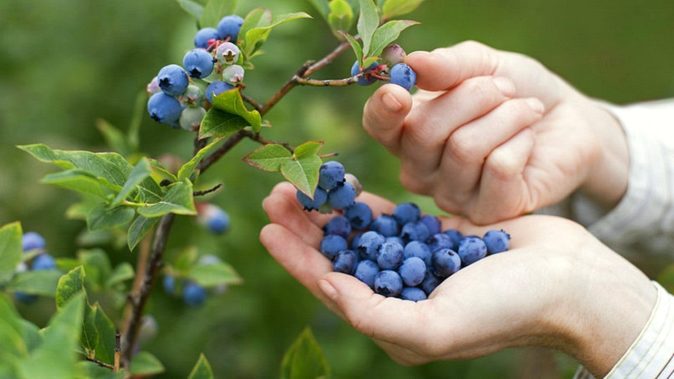

Having created the necessary soil conditions for blueberries, you can count on a good harvest.
For better rooting of bushes, it is recommended to use a hydrogel. 10 g of the substance is poured into 3 liters of water and, after swelling, is mixed with the soil. The hydrogel retains moisture in the soil for a long time and protects the roots from waterlogging, which is especially important for young plants. The hydrogel acts as a reserve source of moisture that can water the shrubs, prevent them from withering and drying out during severe drought and heat.
Important! Adding hydrogel to the soil has a beneficial effect on plants, promotes their more intensive growth and better fruiting, and increases stress resistance.
Step-by-step process of preparing a site for planting blueberry bushes:
- Dig holes 60 cm wide to a depth of 80 cm, leaving a distance of 1 m between them.
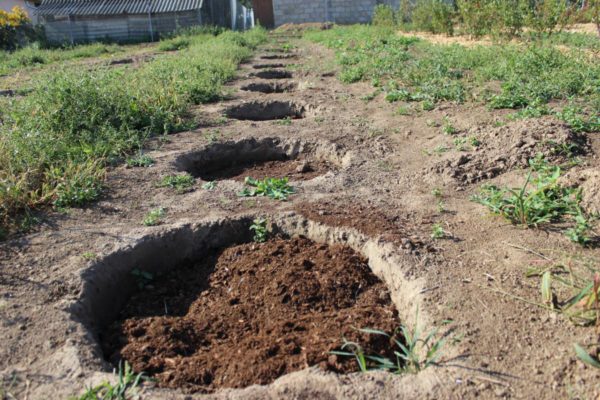

Blueberry pits are prepared in advance so that the donkey soil
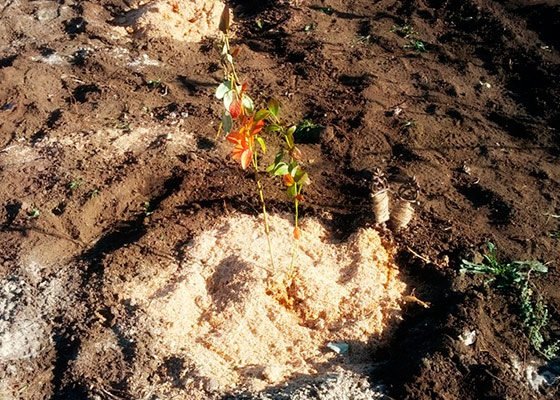

The blueberry bush is covered with earth, not deeply deepening
Video: advice for gardeners on growing garden blueberries
In the future, blueberries are moistened with 2 buckets of water twice a week. To maintain the pH level, the soil is acidified 2 times a year. In areas with neutral acidity, foliage turns yellow, shoots stop growing, the bush withers and may die.
In the first years after planting, pruning of blueberries is not required, only broken or dry branches need to be removed. In the fourth season, after leaf fall, regulating pruning is carried out, leaving 6–8 of the strongest shoots on the bush. The blueberry bush should be well lit and ventilated. Over time, rejuvenating pruning is carried out, gradually replacing old branches with new ones. Blueberries should be fed only with mineral fertilizers in small quantities (for example, Aelita fruit and berry - 20 g per 10 liters of water).
On a note.Blueberry bushes can be used to create a container garden by planting the plants in decorative vessels 70 cm deep and with drainage holes. Blueberries are planted in containers filled with prepared soil with high acidity. At the beginning of June, chlorine-free fertilizers Aciplex (20 g per plant) or Piafoscan blue (30 g) are introduced into the soil, embedding them in the soil. In subsequent years, the amount of fertilizing salt is increased to 60 g per bush. The maintenance of a container garden is the same as for plants planted in the ground.
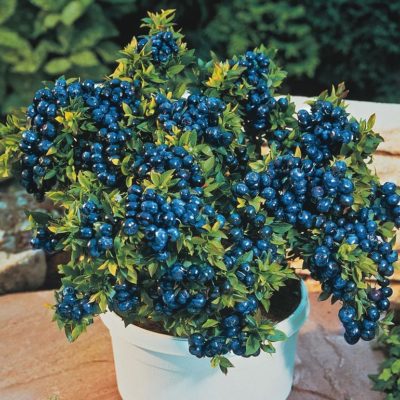

From blueberry bushes, you can create a container garden that will decorate any corner of the site
Care Tips
Regular and proper care is one of the main conditions for a good blueberry harvest. Berry culture needs standard agricultural techniques, including watering, fertilizing, shaping, protective treatments and shelter from frost.
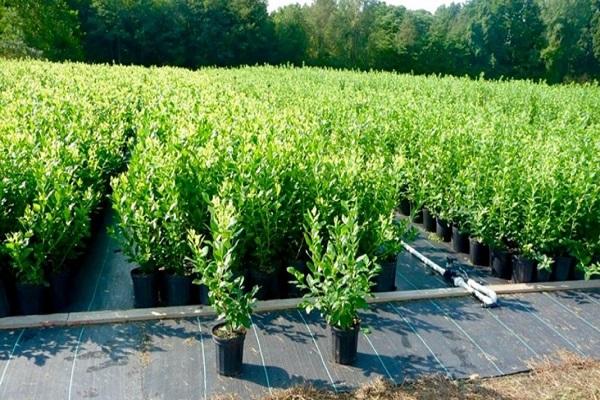

Fertilizing and feeding crops
They begin to use fertilizing from the second year of development of seedlings, since annual plants do not need them. Organic and mineral fertilizers should be used to fertilize blueberries. Organic matter is introduced in late autumn, using compost, bird droppings, rotted manure and peat crumbs. Mineral dressing is applied in the spring, after the snow cover disappears.
Nitroammophoska is best suited as a mineral fertilizer. When the bushes begin to bloom, it is allowed to use an extraordinary top dressing.
Watering
The roots of garden blueberries, located at a depth of 15-20 cm, develop under conditions of constant stay in a humidified environment. In summer, during periods of drought, the berry culture is watered 2 times a week, spending a bucket of liquid for each bush. Watering is carried out monthly with an acidified solution in order to maintain the optimal acidity of the soil. When irrigating abundantly, it is important to avoid excess moisture, as this can lead to root rot and plant death..
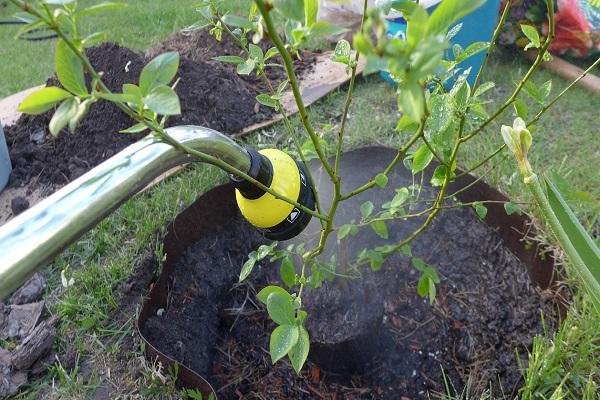

Pruning
For garden and forest blueberries, a strong thickening of the ground part is characteristic. The formation of bush blueberries is carried out annually, starting from the 3rd year of life. Plants are pruned so that the flower buds are evenly spaced on the crown. Damaged, weak and diseased shoots are removed during the pruning process.
The tops of the old branches are pinched, leaving 5-6 buds on them, which contributes to an increase in the size of the berry. Adult shoots bearing fruit for more than 4 years are cut at the root. Shrubs over 15 years old need radical formation - the top is completely cut off, leaving a stem no more than 25 cm high, which helps to intensively rejuvenate the plantation.
Pruning should be done in early spring, before the buds swell, or in the fall, after the foliage has fallen off. Plants grown in the garden in the country and plantations that are intended for the development of the house need pruning.


Wintering
Frost-resistant types of berry crops do not need to be covered for the winter. At the same time, common blueberries may suffer from recurrent spring frosts. To prevent the death of plants, you should use a covering material, which is suitable for dense fabric, burlap or opaque plastic wrap. For shelter for the wintering of large shrubs, you will need to use supports that will help hold the material.
Planting methods for blueberries
It is not difficult to propagate garden blueberry bushes independently by seed or vegetative methods.
Sowing with seeds
Ripe berries are kneaded, dipped in water and stirred. Several times the water is poured with the seeds floating on the surface. Seeds that have settled to the bottom are dried and sown in wet peat in a greenhouse. Water it regularly, open it slightly for ventilation. Shoots should appear in 2 weeks. The film is removed and the containers with sprouts are removed for the winter in a well-lit cool room (with a temperature of + 5-10 0 С).You can take the pots out into the garden, but be sure to cover them with agrofibre folded in several layers.
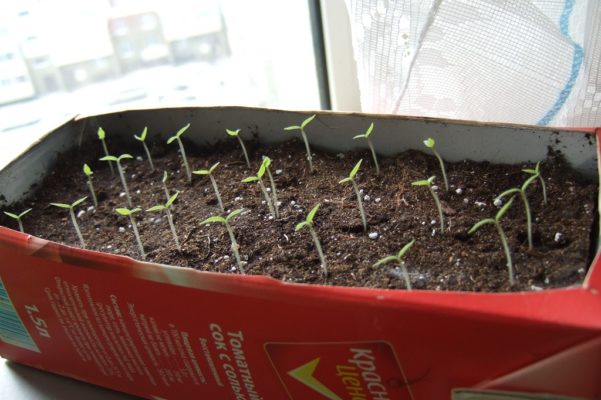

Two weeks after sowing blueberry seeds, shoots appear
In the spring, after the soil thaws, the shelter is removed, the sprouted seedlings dive into boxes and put in a place protected from wind and direct sunlight for growing. The seedlings are transplanted to a permanent place a year later in late summer or early autumn. The berries will appear in the third year.
On a note. Sowing seeds can also be used from frozen berries. It is advisable to immerse them in a 1% solution of a growth stimulant (for example, Epin) for 2 hours before planting.
Video: how to grow blueberries from seeds
Planting seedlings
For planting, you should purchase 2-3-year-old bushes in pots. Bare-rooted blueberries dry out very quickly and may not take root. The container plant is removed from the package before planting and immersed in water for half an hour. Seedlings are planted in pre-prepared pits, watered and mulched.
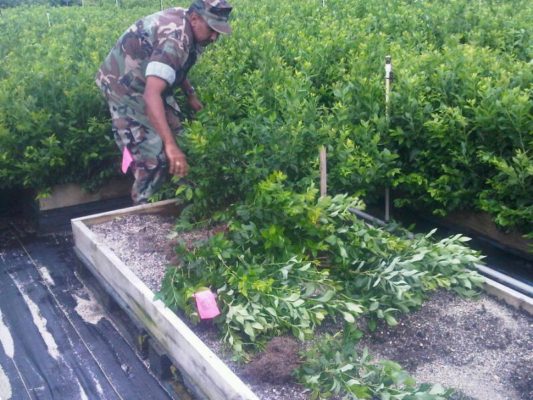

For planting, it is better to use two-three-year-old blueberry bushes.
Division of the mother bush
In the fall, a blueberry bush is dug up and carefully divided so that each part is a relatively autonomous plant and has roots and shoots with intact buds. Such bushes associated with the parent ground or root shoot are called "partial". For good survival, each layer must have at least five healthy buds. The divisions are planted in the garden on a pre-prepared area or in a spacious pot and left to winter in a cool room.
Planting cuttings
When propagating by cuttings, young shoots are cut into pieces of 5–7 cm at the end of June. The upper leaves are slightly cut off, the lower ones are cut off. The cuttings are dipped for an hour in a solution with Kornevin or Heteroauxin, which stimulate root formation, and planted in pots with peat soil. Watered and covered with foil. Within a month, the soil is moistened, airing is carried out. Rooted green cuttings are planted in a growing area. Young plants are planted in a permanent place in the fall or next spring.
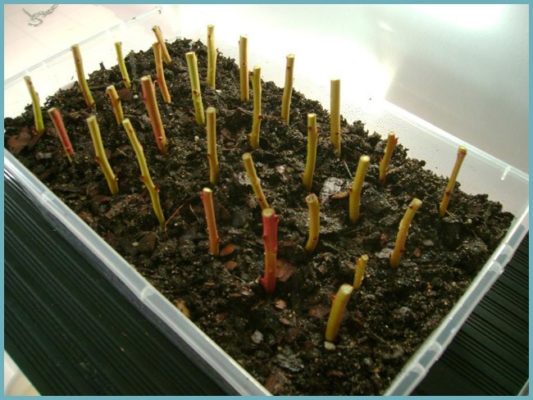

It is not difficult to propagate garden blueberries by cuttings that are harvested in the summer.
The subtleties of growing
When planting blueberry bushes, you must follow the correct technology. To get a large harvest and ensure the active development of the plantings, it is also important to prepare the seedlings and a suitable place in the garden.
Choosing the time and place for boarding
Blueberries can be planted in the spring, after the likelihood of return frosts has disappeared, or in early autumn. In practice, plants planted in late September - early October take root best..
The horticultural culture loves semi-shaded areas and high levels of humidity. You can plant bushes in sunny areas, but you will need to additionally spray the ground part.
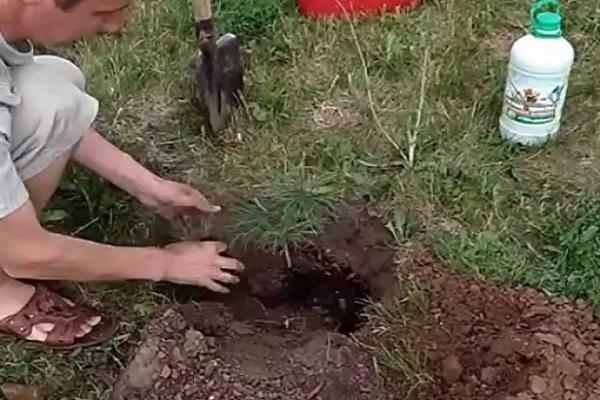

Preparation of planting material
When choosing seedlings, you need to pay attention to the roots. Plants with an open root system require special conditions for transportation and storage. It is recommended to give preference to two-year-old seedlings. Before planting in the ground, blueberry roots are soaked in water for 15-20 minutes.
If you plan to seed blueberries, you first need to sort the planting material and select seeds without damage and rot. The selected planting material is disinfected in a weakly concentrated solution of potassium permanganate. Also, the disinfection procedure can be performed by heating at a temperature of 40 degrees. Then the seeds are soaked for germination. The seed can be transferred directly into the ground or grown in separate pots on the windowsill.
See also
Ways and methods of breeding sea buckthorn at homeRead
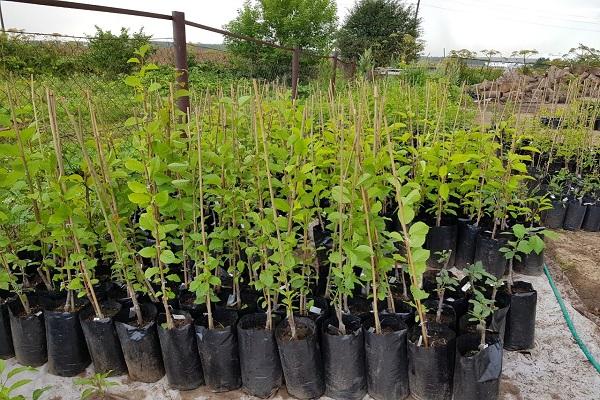

Landing technology
Before planting the seedlings, holes are dug in the garden plot with a size of 1.5 x 1.5 m and a depth of about 60 cm. The bottom of the soil is fertilized with organic fertilizing for the active development of roots. When grown on heavy soil, it is recommended to add river sand or rotted oak foliage to the soil mixture.
Prepared seedlings are placed in the center of the holes and sprinkled with earth. Then the plants are watered abundantly. If planting is carried out in the fall, depending on weather conditions, it may be necessary to use a covering material for immature plants.
Transplanting blueberries to a new location
The need to transplant an adult plant may arise when you need to rejuvenate a bush or find a more suitable place. Garden blueberry bushes easily tolerate transplanting.
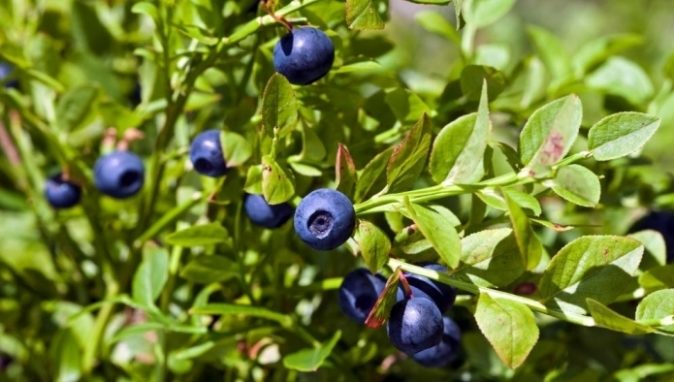

An old blueberry bush transplanted to a new place, after rejuvenating pruning, significantly increases productivity
In late spring or autumn, the plant is dug up along with a large clod of earth and planted in a new place. Sprinkle with soil, water and mulch. Old bushes with the help of pruning rejuvenate: they completely cut off all branches, leaving hemp no more than 20 cm.
Diseases and pests
Garden blueberries are highly resistant to diseases and are poorly attacked by pests. Under unfavorable conditions and insufficient nutrition, the plant's immunity decreases, it becomes susceptible to fungal and viral infections - stem cancer, rot, phomopsis, red leaf spot, berry mummification, mosaic. Since such diseases spread very quickly through the blueberry tree, you need to act after the first symptoms appear:
- leaves become covered with spots, curl, fall off;
- bark, branches, inflorescences dry out;
- berries, shoots stop developing and die off.
Affected plant parts are removed and burned. The blueberry tree is treated with Topsin, Euparen, Fundazol. To prevent fungal diseases, the root zone is sprayed with Bordeaux liquid twice a year. Before flowering and after picking berries, it is recommended to treat the bushes of garden blueberries with the preparations "Skor", "Tersel", "Tridex", "Fufanon".
Pests attack the blueberry tree to a lesser extent and do little harm. Sometimes it is enough just to pick them up by hand. Most often, on a bush of garden blueberries, you can find caterpillars, aphids, flower beetles, leaf rollers, kidney mites, and beetles. If the mechanical method of fighting is ineffective, it is worth resorting to popular insecticides: Fitoverm, Aktara, Dendrobacillin, Bitoxibacillin.
They damage the harvest of blueberry trees and poultry; for protection, the bushes need to be covered with a fine mesh.
Testimonials
It is preferable to plant blueberries in October and before early November. You can plant bushes in spring from March to April. It is best to plant two to three year old bushes, and older plants take root and soon bear fruit.
GENCE197420
We need to buy sour peat, wee 2–4! Dig a big hole 1x1, fill up and plant! pour water with vinegar once a week, if clay soil - drainage from expanded clay. Growing with a bang! Sea of berries.
Anonymous
It is better to propagate by cuttings, at one time I planted a couple of bushes. They still bear fruit. Planted next to currant bushes, so that not in an open place. But it's better to buy in a trusted place, otherwise it is not known which variety you will buy, and whether blueberries at all.
Varchenov
Four years ago, I planted several young blueberry bushes on a prepared bed. In August, I made the soil for the beds based on peat mixed with sand, sawdust, with a small addition of sulfur (a quarter of a teaspoon). The bushes are located in the shade of the wettest place of the site. I planted it in two rows at a distance of 40 cm, sprinkling with diluted citric acid in water in a ratio of 1 to 10. The first fruits appeared only this year.
matros2012
Blueberries are a valuable berry crop. Growing it in the garden is not so difficult, you just need to follow the rules of agricultural technology.Gardeners love domesticated blueberries for their delicious berries that can be enjoyed in the comfort of your home. Blueberry leaves and fruits are also widely used to boost immunity and improve vision. A beautiful shrub of light green color, which acquires a reddish tint in autumn, will serve as an excellent decorative decoration of the site.
Blueberry is a low and highly branched berry shrub from the heather family. It easily and unpretentiously tolerates winter frosts; blueberries can be found beyond the Arctic Circle. In the wild, it grows in mixed or coniferous forests, most often in the latter. Some pine forests are so overgrown with blueberry bushes that they are called so: blueberry pine forests.
In general, this neighborhood is not accidental. Like pine, blueberries thrive on acidic soils with close groundwater. It is also a shade-loving shrub, so it should be planted under the canopy of trees that can provide constant partial shade under them.
Planting blueberries
Before planting blueberries, it is necessary to prepare in advance the area where it will grow in the future. Usually garden soil is not acidic enough, so premature planting of blueberry bushes in unprepared soil can lead to yellowing of the leaves, stunted development and even death of the plant. For successful cultivation, pits 150x150 cm in size and 60 cm deep each are prepared for each bush. The excavated soil from the pits is mixed with peat chips (in a 2: 1 ratio) to further acidify the soil, add powdered sulfur. Also, if possible, you can add kitchen cleaners and oak leaves, and river sand in heavy soils. Such preparation is carried out in advance, the main thing is that the prepared soil settles in the pits before planting. For example, if you planned to plant blueberry bushes in October, the soil must be prepared no later than September.
The main types of blueberries
Common blueberry - Vaccinium myrtillus
Common blueberries grow in the European part of Russia, Eastern and Western Siberia, the Far East, in the Northern part of North America. It grows in deciduous and coniferous forests, in the tundra, forest-tundra, on sphagnum bogs, in the mountains up to 2000 m above sea level. Often dominates the vegetation cover, forming extensive thickets. Protected in reserves.
Blueberries have a wide ecological range. It is undemanding to humidity, it is found both on the outskirts of bogs and in damp forests, and in dry, clarified areas. It prefers lightened places, but it can grow in shaded areas, however, in completely open areas it often completely or partially dies off. It is more sensitive to temperature fluctuations than lingonberry. Prefers richer soils than lingonberries. It grows on the plain and in the mountains, rising to a height of 2800 m above sea level. m., but usually does not bear fruit at the upper border of the forest.
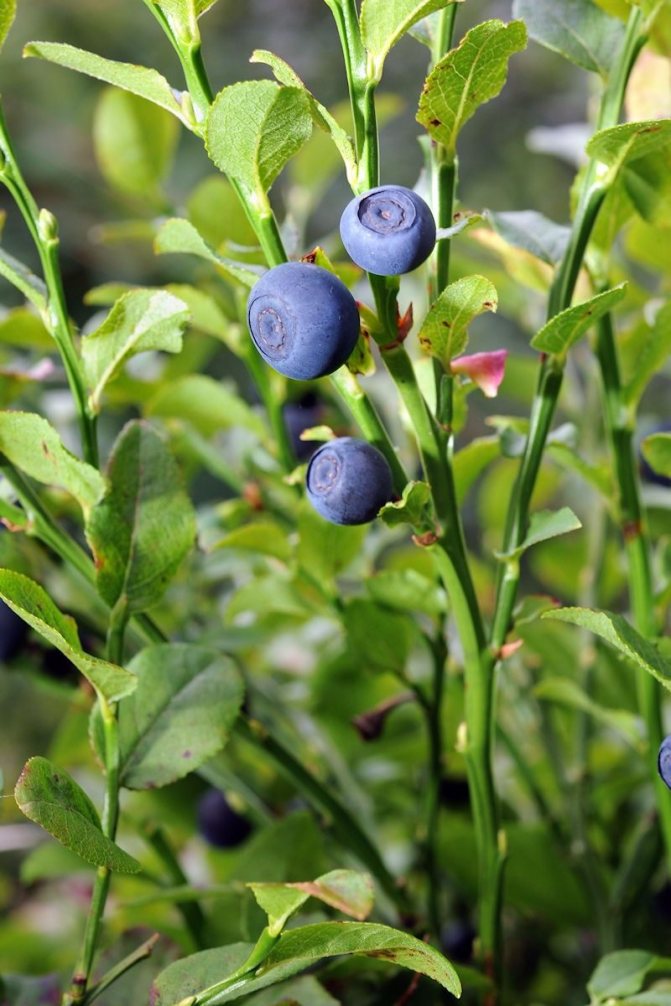

Bilberry, or Common Bilberry, or Myrtle-leaved Bilberry (Vaccinium myrtillus). <>
Caucasian blueberry - Vaccinium arctostaphylos
Caucasian bilberry, or Caucasian bilberry - The only tertiary relic of the species growing in the territory of the former USSR, rising into the mountains to the upper forest belt. Distributed in the Caucasus and Northern Asia Minor (as well as in Southeast Bulgaria and Northern Iran). Grows in the mountains mainly at an altitude of 1000-2000 m above sea level. seas, in beech, fir and spruce-beech, less often in chestnut and oak forests. In the belt of the subalpine crooked forest it forms thickets. Protected in reserves.
It is a large deciduous shrub or small tree, up to 2-3 m high, with edible fruits, growing in Colchis forests and glades. Leaves (6-8 cm long) and fruits are larger than those of common blueberries. Blooms in May-July; fruits ripen in July-August. Caucasian blueberries are used on a par with common blueberries.
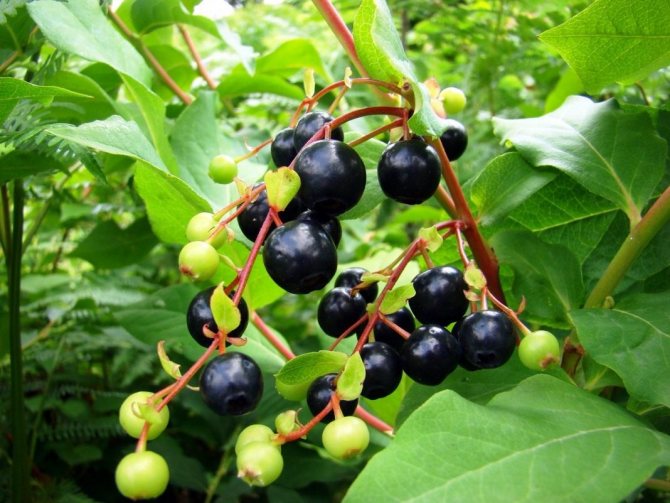

Caucasian blueberry, or Caucasian blueberry (Vaccinium arctostaphylos). <>
Bilberry oval - Vaccinium ovalifolium
Oval-leaved blueberry is a plant species from North America Primorye, Sakhalin Islands, Komandorskie, Kuril, Aleutian, Japan, North America. It grows in coniferous and mixed forests on mountain slopes and in marshy lowlands, in thickets of dwarf cedar, often forms large thickets.
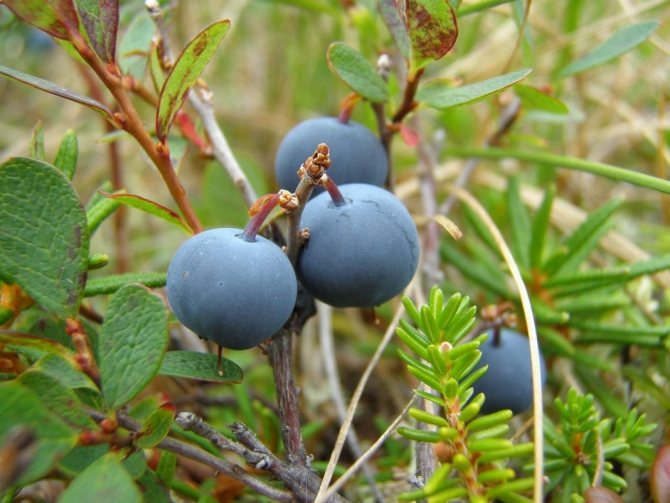

Bilberry oval, or Bilberry oval, or Vaccinium ovalifolium. <>
Advantages and disadvantages
This culture has many useful properties, which is why many want to breed it in their summer cottages. It is worth considering them in more detail:
- increased visual acuity;
- treatment of colds;
- improvement of the digestive tract;
- acceleration of metabolism;
- prevention of rheumatism;
- help in the treatment of the gallbladder and liver;
- restoration of the menstrual cycle;
- lowering blood sugar levels;
- strengthening of immunity;
- effective fat burning.
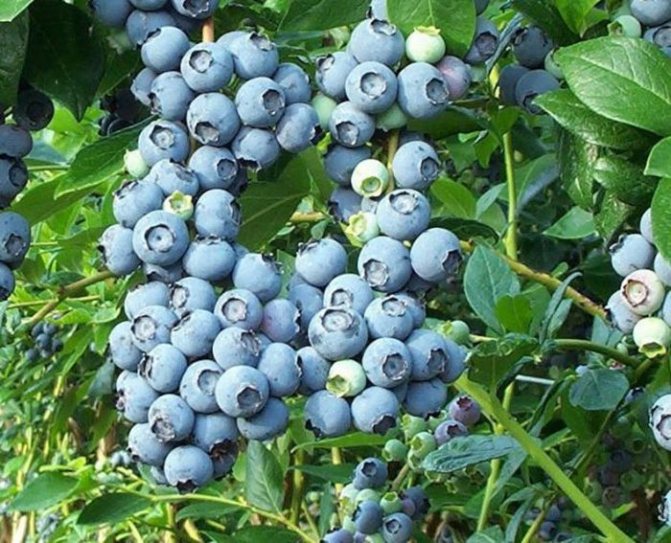

However, there are still several negative nuances that you also need to remember. It is forbidden to eat blueberries in the following cases:
- disruption of the pancreas;
- the diagnosis of oxalaturia;
- urolithiasis disease;
- provoking constipation with excessive use;
- individual intolerance.
Important. If you plan to use blueberries in medicines, it is recommended to consult a doctor. This will allow you to understand how appropriate it is to use it and whether there is any risk.
Botanical description of culture
Blueberries belong to perennial low-growing plants from the Heather family. The plant reaches 15-30 centimeters in height. The branches of the culture form an acute angle with the main trunk. The leaves are ovoid and fall off for the winter. The plant is characterized by creeping roots with many shoots.
Flowering begins in May. The flowers are greenish-white. The whisk includes 5 cloves. The flower is inclined downward, which protects the pollen from moisture. The berries are blue-black and are actively used for medicinal purposes. Sometimes blueberries are cultivated as an ornamental plant.
Fertilizing and feeding crops
Despite the frequent recommendations for the application of organic fertilizers, this cannot be done. Blueberries react poorly to feeding with manure or bird droppings. She can get sick, develop worse, give a bad harvest, or even die altogether. Therefore, if you add fertilizer to the soil, then only mineral fertilizer. Dosage - no more than 1 tbsp. for 1 sq. m.
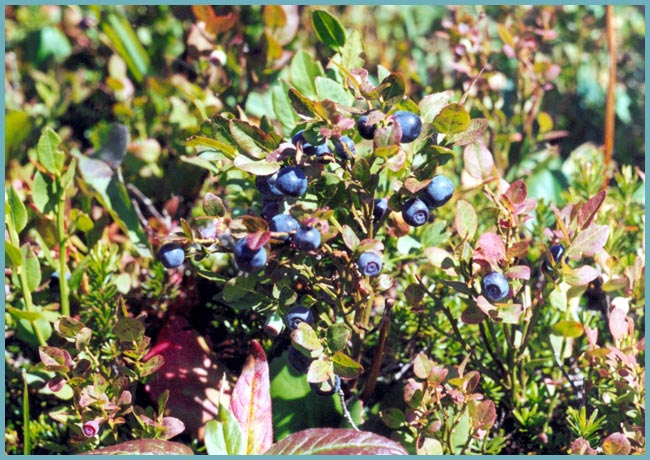

No need to fertilize blueberries
Every 2-3 years, under blueberry plantings, you need to renew the soil. For this, peat mixed with sand is poured. You can feed the bushes with a mixture of sawdust, dry grass, leaves.
Attention! The plant does not tolerate fertilizing containing chlorine.
Pruning
Mid-March is considered a good time for pruning the plant. Before the procedure, you need to look at the weather conditions, there should be no frosts.
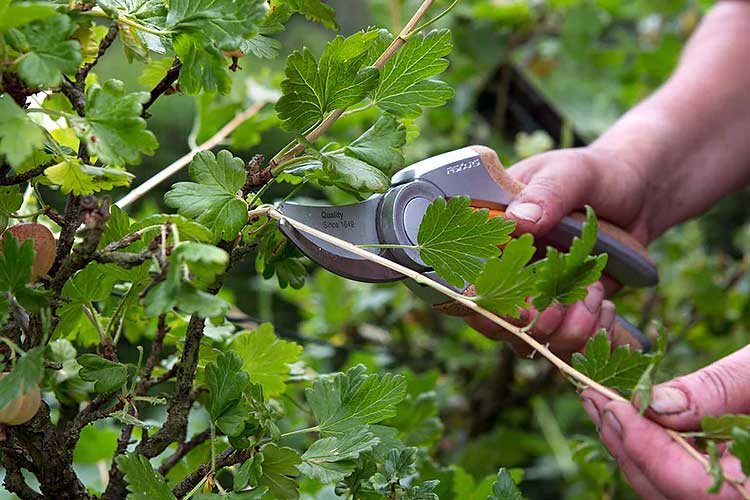

Sharp pruning tool
Regular pruning is carried out 3 years after planting the seedlings. To begin with, an inspection of the bush is carried out, first of all, dried, diseased and damaged branches are removed. Up to 8 main strong healthy branches are enough on one bush.
In order for new shoots to grow, old branches are cut to 20 cm. If there are many side shoots on the bush, then they are removed, since small berries grow on them.
Adult shrubs aged 15 years and more are cut completely to a height of 20 cm. The procedure is rejuvenating, it allows you to preserve the yield of blueberries.
The best varieties of blueberries
Today, a large number of varieties of this berry are known. They differ in taste, fruiting period, and the appearance of the bushes.
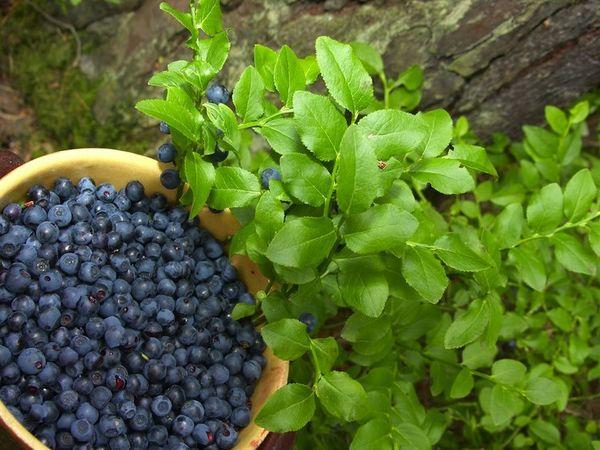

Forest
Wild blueberries grow in the forest. It is very problematic to adapt the plant for cultivation in the country.This is due to the increased sensitivity of the root system to transplantation. Also, culture requires special conditions of detention. Therefore, the berries are usually harvested in the forests.
Sadovaya
Special varieties of bush blueberries can be grown in the garden:
- Bluecrop is one of the most successful choices and is popular with many gardeners. This shrub is characterized by high frost resistance. The culture is able to tolerate a decrease in temperature to -35 degrees.
- Patriot - the bush reaches 1.5 meters and has a not very dense crown. The plant develops quickly enough. It is distinguished by slightly flattened fruits that have a pronounced aroma. The advantages of the variety are frost resistance and good immunity.
- Herbert is a tall plant that grows up to 2 meters. This garden crop is characterized by late flowering, which avoids recurrent frosts. The plant is highly resistant to frost and drought.
- Chanticleer is the earliest cultivar, flowering immediately after the last frost of spring. The bush reaches 1.5 meters in height and produces a good harvest.
- Spartan is a fairly tall bush that grows up to 2 meters. The harvest ripens at the end of July. It is possible to collect 5-8 kilograms of fruit from 1 bush. They are not very large in size, but they have an excellent aroma and dense pulp. The plant does not suffer from moniliosis.
See also
Rules and methods for keeping blueberries at home for the winter
To read
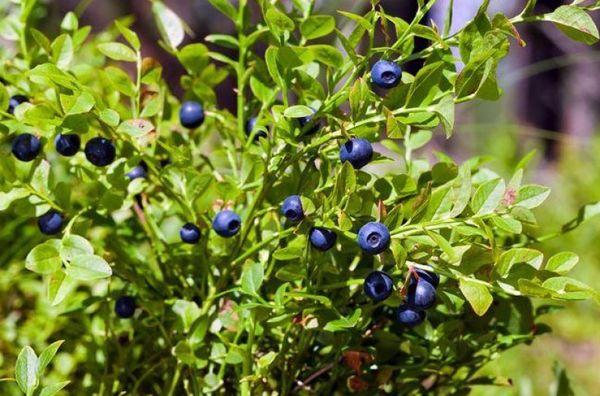

In addition to the common blueberry, there is also the sunberry. It is an annual plant that has been bred on the basis of different types of creeping nightshade. The crop is characterized by good yields and large, shiny berries.
Recommendations for the choice of planting material
For planting, it is advisable to purchase a two-year-old seedling with a closed root system. It must be fresh, free from pests and diseases.
The root system must have at least five main roots. It is best not to purchase a plant with exposed roots and foliage.
After purchase, seedlings are stored for no more than two weeks.
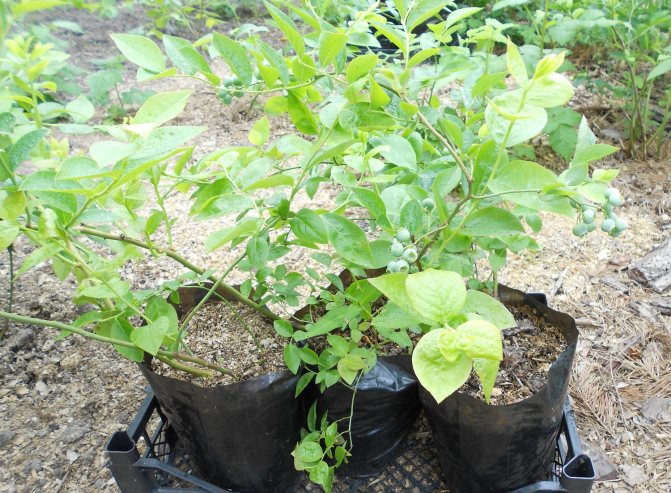

A young blueberry bush can be easily confused with blueberries. People realize they were wrong when the first crop arrives.
The berries of blueberries are sour and watery, their flesh is greenish, and the juice does not stain hands. Blueberries are high in nutrients.
The blueberry seedlings are actually irga. The berries of this tree are covered with a bluish bloom; they also paint with hand juice.
However, Irga belongs to the Pink family and has other morphological characteristics.
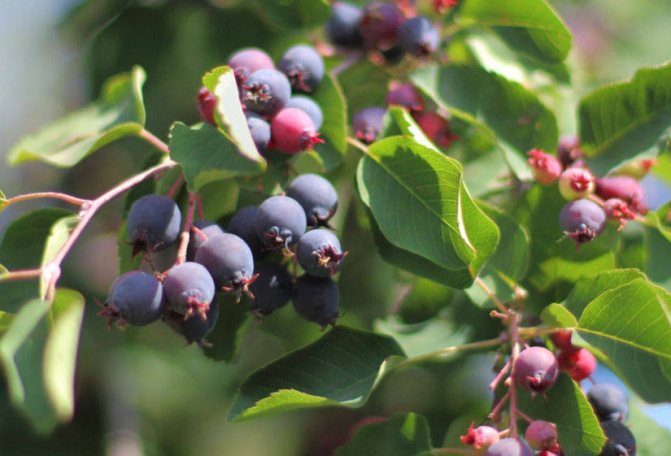

On the Internet, you can find information about annual blueberries. It is clear that shrubs do not belong to annual crops.
It is a herbaceous plant from the Solanaceae family. Vegetable Saraha resembles blueberries both in appearance and taste.
Bushes bear fruit until frost. The berries themselves can be eaten fresh or prepared for compotes and jams.
Care after landing
The first few days you need to spend one root and one foliar feeding. Due to the fact that the soil under the roots must be kept intact, all fertilizers are applied in liquid form. Now, nitrogen and phosphorus are best suited, as well as a complex of microelements. We add a solution of colloidal sulfur to the fertilizer mixture, since top dressing, especially nitrogen fertilizers, reduce the acidity level of the substrate.
Water it in a small amount around the bush, pour it under the root. We fertilize in the evening, it is desirable that the temperature of the water with fertilizers in the watering can be higher than the air temperature. This will ensure better absorption by the roots.
Competent care is not to leave the landing site immediately, leaving things to chance.
Foliar dressing is carried out with a solution of trace elements and the same colloidal sulfur to protect against spider mites. We also spray in the evening, when the heat subsides and moisture does not act on the leaves like lenses, causing them sunburn.
After a couple of weeks, the leaves are filled with color, shoots begin to grow from the tops of the branches. This means that the bush has taken root. We can assume that the planting of garden blueberries was successful.
Garden blueberries: planting and care. Brief plan of operations
Blueberries: Combine with Other Plants and Harvest
This culture is valuable not only for its useful properties, but also for decorativeness. In Europe, they are engaged in the cultivation and reproduction of different varieties of blueberries to decorate garden plots, especially shady ones.
It looks good in rockeries and group plantings. The combination of this shrub with conifers is considered successful. You can also plant a plant under deciduous trees, but refrain from the proximity in open ground with fruit trees, under which you apply organic fertilizers. Berry bushes border ponds and garden paths.
Advice. Blueberries lend themselves well to shearing: they are used to make curbs of different heights.
Harvesting begins in summer and lasts until autumn. It is best to do this in dry weather. Fresh berries are delicious, but when combined with strawberries, raspberries, strawberries, and cloudberries can cause stomach upset. For the winter, blueberries are dried, frozen, compotes and jams are made from them. Well, the classic blueberry treat is a delicious jam with the aroma of a sunny summer.
Growing area
Blueberries are found in coniferous forests and marshy areas. Sometimes bushes can be seen in mixed plantings. Under natural conditions, the berry grows only in the northern hemisphere. It is impossible to find a plant in a warm climate or in a steppe area.
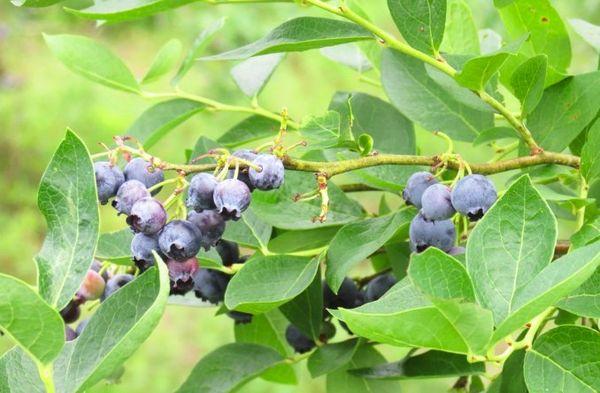

In Russia, the plant is found in Siberia, Karelia, and the Tyumen region. It also grows in the north of the Urals and Trans-Urals. To grow blueberries in the Moscow region, it is worth choosing specially adapted varieties of garden culture.
Naturally, blueberries can be found in Northern Europe and East Asia. The berry can grow in areas with high to moderate humidity. In such areas, a large number of bushes are found. In some areas, the berry covers an area of several tens of kilometers.
Useful properties of berries
Blueberries are considered an unusually healthy berry:
- The composition contains many organic acids. These include lemon, milk, apple. These components have a beneficial effect on the digestive organs, help to cope with the symptoms of poisoning, and eliminate stool disorders.
- The presence of mineral salts of manganese, potassium, iron, phosphorus in blueberries supports the normal functioning of the human body.
- The leaves of the plant help to cope with the symptoms of diabetes.
- The presence of vitamins B, PP, C and carotene helps to strengthen the immune system. Berries have a beneficial effect on the condition of the retina.
- A large amount of antioxidants in berries reduces the likelihood of developing pathologies of the heart and blood vessels.
- The plant has bactericidal properties. It helps to eliminate inflammation in the kidneys and genitourinary system.
- Blueberry leaf tea treats headaches and symptoms of colds.


